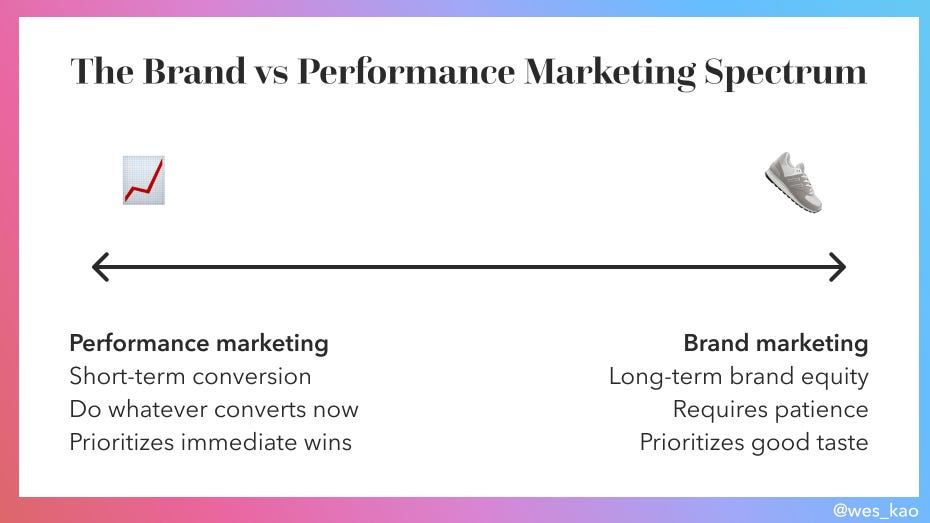Balancing Long-Term Branding with Short-Term Performance Marketing
Maximize growth by balancing immediate sales with lasting brand loyalty through aligned marketing strategies
Marketing has one fundamental goal: grow revenue. To achieve this, businesses need to build a strong brand while driving immediate sales. But how do you balance cultivating brand equity over time with achieving quick, measurable results?
Let's dive into practical strategies to find this balance.
Understanding the Two Approaches
Brand Building
Brand building is about creating an identity and positioning that resonates with customers. It shapes perceptions, builds emotional connections, and fosters loyalty. The focus is on long-term growth, brand equity, and differentiation.
Performance Marketing
Performance marketing targets immediate results. It uses tactics like online ads, clicks, and conversions to drive quick sales. Metrics like Return on Ad Spend (ROAS) and Cost Per Acquisition (CPA) are paramount. The aim is to generate measurable outcomes now.
How They Complement Each Other
Not a Zero-Sum Game
Contrary to popular belief, brand building and performance marketing aren't mutually exclusive. In fact, they can enhance each other. A well-recognized brand can improve the effectiveness of your performance marketing efforts, lowering costs and increasing conversion rates.
The Risks of Neglecting One for the Other
Focusing solely on short-term sales can erode your brand over time. Customers might see you as pushy or insincere. On the other hand, investing only in brand building without driving immediate sales can strain your finances.
Measuring Brand Building with Commercial Metrics
Linking brand-building efforts to financial results can be challenging, but it's essential. Here are some methods:
Brand Equity Measurement
Track metrics like brand awareness, consideration, and sentiment over time. Tools like brand health surveys and social listening platforms help translate branding efforts into consumer perceptions.
Customer Lifetime Value (CLV)
CLV measures the total worth of a customer over their entire relationship with your business. An increasing CLV suggests brand investments are deepening customer relationships, leading to repeat purchases and advocacy.
Brand Elasticity of Demand
This metric assesses how brand strength affects price sensitivity. Strong brands can command higher prices because customers perceive more value and are less price-sensitive.
Share of Voice (SOV) vs. Share of Market (SOM)
Research indicates that when a brand's SOV exceeds its SOM, it's more likely to grow market share. Increasing SOV through sustained marketing investment signals future sales growth.
Emotional and Rational Brand Value Metrics
Evaluate both emotional connections (like brand love and loyalty) and rational factors (like perceived quality and value for money). Brands with high scores in meaningful differentiation tend to achieve stronger sales growth.
Practical Strategies for Balancing Both
1. Aligning Objectives and Budget Ratios
Allocate your marketing budget to reflect both short-term and long-term goals. The ratio depends on your business type:
Luxury Goods and Lifestyle Brands
Emotional connection is key. A 70/30 split favoring long-term brand investments is often appropriate.
E-commerce and Subscription Services
Frequent transactions drive revenue. A 60/40 or even 50/50 split ensures brand-building provides a foundation while performance marketing drives conversions.
Fast-Moving Consumer Goods
Maintain top-of-mind awareness and drive repeat purchases. A 65/35 ratio allows for continuous brand presence supplemented by targeted performance marketing.
Marketing experts usually suggest a 60/40 investment split between brand building and sales activation.
Strategies for Success
Integrate Your Messaging: Ensure that your performance marketing campaigns reflect your brand values. Consistency builds trust.
Allocate Resources Wisely: Consider splitting your marketing budget to cover both areas. For instance, dedicate 60% to brand building and 40% to performance marketing, or adjust based on your industry and goals.
Measure and Adapt: Use metrics to assess both short-term and long-term results. Adjust your strategies accordingly.
Example
A Dutch electric mobility company ran a brand awareness campaign alongside performance marketing efforts. After launching a TV commercial, they saw a 300% increase in organic brand traffic. Additionally, their cost-per-click for online ads decreased by up to 45%, demonstrating how brand building can enhance performance marketing results.
2. Managing Leadership Expectations
Educate company leaders about the long-term benefits of brand investments:
Use Data and Case Studies
Show how companies maintaining brand spending during downturns outperform competitors. Emphasize the "compound interest" effect of brand equity.
Balanced Scorecard Approach
Develop KPIs that reflect both long-term and short-term goals. Combine metrics like Customer Acquisition Cost (CAC) with CLV or SOV alongside brand consideration scores.
Brand Health Metrics
Introduce brand health metrics into quarterly reports. Tracking changes in brand perception and emotional engagement provides early signals of future financial performance.
Highlight Risks of Overemphasis on Short-Term Metrics
Excessive reliance on discounts may erode brand equity, leading to price-sensitive customers.
Navigating External Challenges
Economic Uncertainty
During tough economic times, businesses might be tempted to cut brand building efforts to focus on immediate sales. However, reducing investment in your brand can harm long-term growth. Maintaining brand presence is crucial, even when budgets are tight.
Example: In August 2023, Airbnb's Chief Marketing Officer announced a shift away from performance marketing toward bold, brand-focused campaigns. CMO Hiroki Asai explained that before the pandemic, Airbnb was losing its unique identity amid growing competition. The new "Get an Airbnb" campaign aims to refocus on what makes the brand distinctive.
The Data Shift
With increasing privacy regulations and the decline of third-party cookies, collecting first-party data has become vital. Strong brand trust encourages customers to share their information willingly, enabling more personalized and effective marketing.
The Rise of First-Party Data
Why It Matters
First-party data is information you collect directly from your customers. It's more reliable and aligns with privacy laws. Building a strong brand encourages customers to engage and share their data.
Brand Building's Role
A trusted brand makes customers more comfortable sharing personal information. This data can then enhance your performance marketing by allowing more precise targeting and personalization.
Why Balancing Both Matters
Ignoring long-term brand building can weaken overall brand strength and limit market potential. Overemphasis on short-term metrics may lead to diminishing returns.
Data Point: The world's top brands missed an estimated $3.5 trillion in cumulative brand value due to focusing on short-term efficiencies over long-term brand-building.
Conclusion
Balancing long-term branding with short-term performance marketing isn't just smart, it's necessary. Brands need to think beyond immediate gains and invest in building something meaningful.
By aligning objectives, educating leadership, expanding marketing goals across timelines, and integrating brand and performance efforts, businesses can achieve both short-term results and long-term growth.
Remember, if a brand isn't creating lasting value, it's merely a commodity. In a crowded marketplace, commodities don't stand out, they disappear.




Nice work & cool examples!